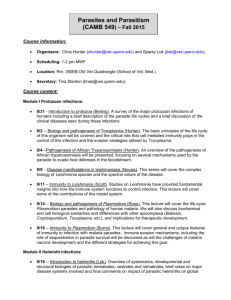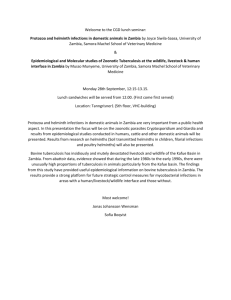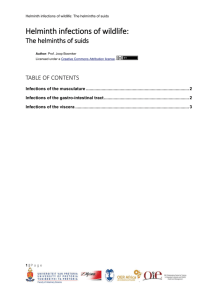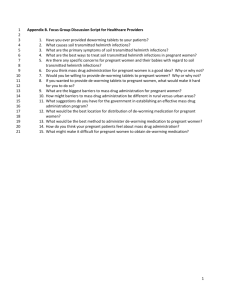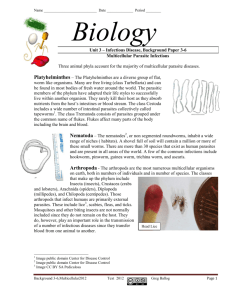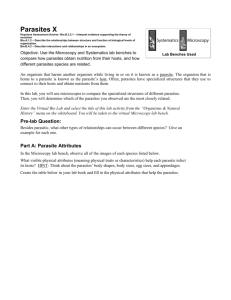01_helminth_ruminants_introduction
advertisement
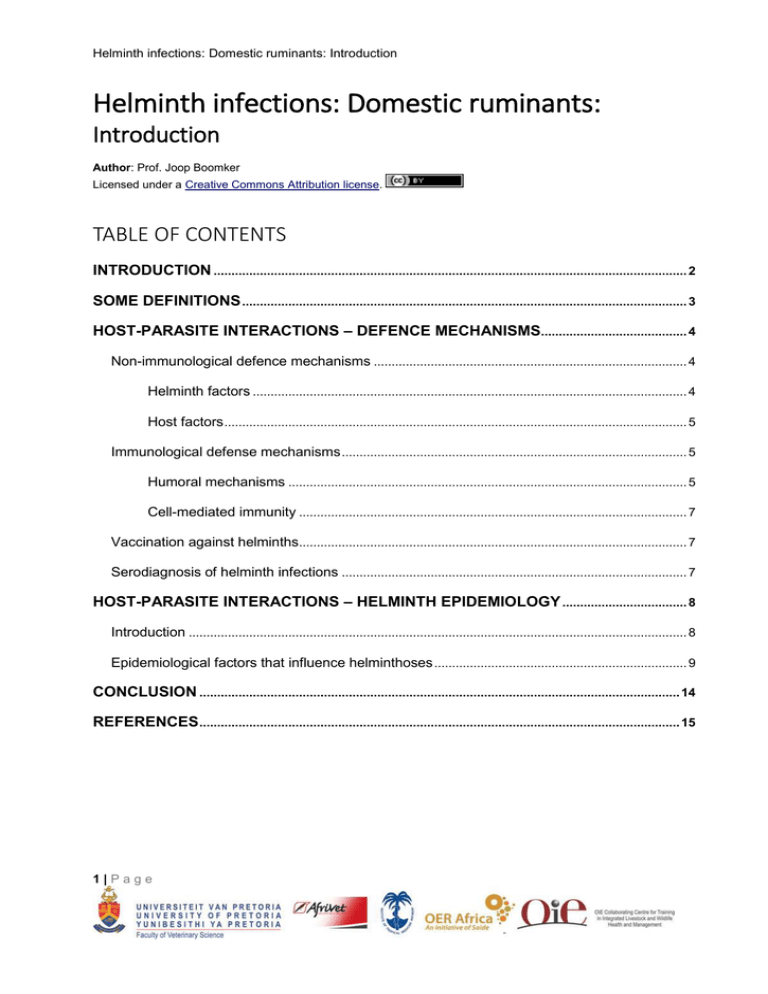
Helminth infections: Domestic ruminants: Introduction
Helminth infections: Domestic ruminants:
Introduction
Author: Prof. Joop Boomker
Licensed under a Creative Commons Attribution license.
TABLE OF CONTENTS
INTRODUCTION ..................................................................................................................................... 2
SOME DEFINITIONS ............................................................................................................................. 3
HOST-PARASITE INTERACTIONS – DEFENCE MECHANISMS......................................... 4
Non-immunological defence mechanisms ........................................................................................ 4
Helminth factors .......................................................................................................................... 4
Host factors .................................................................................................................................. 5
Immunological defense mechanisms ................................................................................................. 5
Humoral mechanisms ................................................................................................................ 5
Cell-mediated immunity ............................................................................................................. 7
Vaccination against helminths............................................................................................................. 7
Serodiagnosis of helminth infections ................................................................................................. 7
HOST-PARASITE INTERACTIONS – HELMINTH EPIDEMIOLOGY ................................... 8
Introduction ............................................................................................................................................ 8
Epidemiological factors that influence helminthoses ....................................................................... 9
CONCLUSION ....................................................................................................................................... 14
REFERENCES ....................................................................................................................................... 15
1|Page
Helminth infections: Domestic ruminants: Introduction
INTRODUCTION
Helminthology is the study of worms, be they roundworms, flatworms, parasitic or free-living. Many
scientists have contributed to the science of helminthology, and currently approximately 5 000 articles
on animal parasites are published annually. These deal with all aspects of helminthology, such as
taxonomy, morphology,
epidemiology.
clinical
pathology,
immunology,
pathogenesis
and
pathology,
and
While the parasitic worms, or even the thought of them, may seem revolting, we should never forget
the old adage, 'unknown is unloved'. The helminth parasites have a beauty of their own, and are so
well adapted to their natural hosts, that they have intricate and highly complex life cycles to enable
them to survive, and all these aspects make them extremely interesting to study. Also taking into
account that very many species are still unknown to science, it is a challenging field in which much
remains to be done. However, a complicating factor is that the study of helminth biodiversity is
an invasive process which is frowned upon by farmers, commercial and subsistence, and animal
rights activists. Because many parasites are internal it is not possible to remove them and leave the
host alive, and artificial media for maintaining parasitic larval and adult stages are not in common
usage.
This course deals with approximately 30 worm species out of thousands that parasitise production
animals, companion animals, wild mammals, birds, fish amphibians and reptiles, insects and other
arthropods, and even plants.
Table: The helminths of domestic ruminants
Trematodes (Flukes)
Fasciola hepatica
Fasciola gigantica
Calicophoron microbothrium
Calicophoron calicophorum
Cotylophoron cotylophorum
Schistosoma mattheei
Cestodes (Tapeworms)
Avitellina spp.
Echinococcus sp. larvae
Moniezia benedeni
Moniezia expansa
Taenia spp. larvae
Thysaniezia sp
Stilesia spp
Pentastomes (Tongueworms)
Armillifer armillatus
2|Page
Helminths of domestic ruminants
Nematodes (Roundworms)
Bunostomum spp.
Chabertia ovina
Cooperia mcmasteri
Cooperia pectinata
Cooperia punctata
Cooperia spatulata
Cooperia oncophora
Nematodirus helvetianus
Nematodirus spathiger
Oesophagostomum columbianum
Oesophagostomum radiatum
Oesophagostomum venulosum
Setaria labiatopapillosa
Strongyloides papillosus
Trichostrongylus axei
Trichostrongylus colubriformis
Trichostrongylus rugatus
Trichostrongylus falculatus
Trichinella spiralis
Helminth infections: Domestic ruminants: Introduction
SOME DEFINITIONS
The definitive host or final host is the host in which the parasite attains sexual maturity and is able
to reproduce.
The intermediate host is the host in which the immature stage of a worm develops, so as to
become infective to the final host. Usually the L1, L2 and L3 occur in the intermediate host. This host
is absent in the life cycles of many of the nematodes but is present in all of the trematodes and
cestodes.
The paratenic host or transport host is similar to the intermediate host, but no development of
the larva takes place. There may be more than one paratenic host involved in a life cycle and
larvae can pass passively (e.g. by being swallowed) from one paratenic host to the next. The larvae
can continue this cycle until they die or are swallowed by the final host, in which they will
resume the usual life cycle. Paratenic hosts are not essential in the life cycle.
A reservoir host is an animal that harbours the parasite, but is not adversely affected by it. Wild
ruminants do not readily show clinical signs, but may be the reservoir hosts of the parasites of
domestic ruminants, which usually react severely to infections.
The life cycle describes the development of a parasite through its various stages, viz.
fertilization, laying of eggs, hatching and development of the larvae (in nematodes usually four larval
stages, in cestodes usually two), infection of the final host and further development into adults. Two
types of life cycle are recognized, namely direct or monoxenous life cycles in which intermediate
hosts do not play a role and indirect or heteroxenous life cycles in which one or more intermediate
hosts are necessary for their completion.
The prepatent or developmental period is the time that elapses after the infective stage has
entered the final host and before the parasite demonstrates its presence by, for instance, eggs in
the faeces, blood or mucus in the faeces or the urine, loss of condition or other clinical signs. This
period refers to the period between infection and the presence of adult worms.
The term infective refers to a stage in the life cycle of a parasite when it is able to enter the next
host. In the case of nematodes, either the egg that contains a first stage larva or the first stage larva
is infective to the intermediate host, while the third larval stage is usually infective to the final host.
In the case of trematodes the miracidium is infective to the intermediate host and either the
cercariae or the metacercariae to the final host. The eggs of cestodes are usually infective to the
intermediate host, while the metacestode, such as a cysticercus, coenurus, hydatid or strobilocercus,
is infective to the final host. The terms infect and infection refers to the process of entering either the
intermediate or the final host.
Hypobiosis and hypobiotic refer to a resting stage in the life cycle that the 4th larval stages of
some of the nematodes undergo in the final host before they develop into adult worms. The term
includes terms such as arrested, retarded, inhibited or suspended development and is similar to
diapause in insects. It is a strictly seasonal occurrence that is triggered by normal seasonal changes
in climate.
3|Page
Helminth infections: Domestic ruminants: Introduction
Histotropic phase or prolonged histotropic phase is induced by the immune status of the host
rather than the season. The larvae, usually the fourth stage, remain in the host's tissues without any
further development. It is a normal part of the life cycle of many nematodes.
Ecology is the study of the interrelationships between organisms and their environment. Abiotic
factors such as temperature, humidity, pH, the presence or absence of light and others, which are
necessary for the survival of the worms, play an important role. Ecological studies usually apply to the
free-living stages of the parasites.
The intensity of infection indicates the number of individuals of a particular parasite species in
each infected host. This is expressed as a number, for instance, an intensity of 2 500 means that
the host is infected with 2 500 parasites. The mean intensity refers to the total number of
individuals of a particular parasite counted in all the animals, divided by the number of infected hosts.
The prevalence is the number of individuals of a host species infected with a certain parasite
divided by the number of hosts examined and is expressed as a percentage. For example:
during a survey 200 sheep were examined and 134 found to be positive for Haemonchus contortus.
The prevalence is: 134 divided by 200, or 67 per cent.
Apart from the above definitions, there are a number of terms that are in everyday use, the meaning
of which will become clear as the course develops.
HOST-PARASITE INTERACTIONS – DEFENCE MECHANISMS
Non-immunological defence mechanisms
Helminth factors
Intraspecies and interspecies competition is known to occur in helminth infestations and this
may have a very definite effect on the number of worms that reach maturity.
With intraspecies competitions, the presence of adult worms frequently prevents larval stages
from developing further and in the case of cestodes it is hypothesized that the original dose of
eggs may stimulate rejection of subsequent doses. This has subsequently been shown to
occur, and the antigens released by the larvae upon hatching stimulates an immunity that
rejects or inhibits subsequent infections. It forms the basis of vaccination against some
Taenia spp. (see 'Vaccination against helminths' below). In addition, the presence of cestode
larvae, e.g. that of Taenia saginata in calves, inhibits the development of newly acquired
ones.
In interspecies competition, competition for mutual habitats and nutritional requirements
serves to control the numbers and species composition of the helminth population. The 'first
come, first served' principle is very much in evidence in the case of Haemonchus contortus,
4|Page
Helminth infections: Domestic ruminants: Introduction
Teladorsagia circumcincta and Trichostrongylus axei, where the first one to arrive in the
abomasum, renders the environment unsuitable for those that follow.
Host factors
Factors that affect the final helminth burden include the age and sex of the host; these appear
to be largely under hormonal control. Thus, in animals whose sexual cycle is seasonal,
parasites tend to synchronize their reproductive cycle with that of the host. For instance, ewes
show a 'spring rise' in faecal nematode ova, especially those of H. contortus, which coincides
with lambing and the onset of lactation. Similarly, the infective larvae ingested in autumn tend
to be retarded until spring. The most evolved techniques of infestation, which are under
hormonal control, are those of the milk-borne nematodes, where the offspring are infested by
drinking milk from an infested mother e.g. Toxocara, Strongyloides and Ancylostoma.
Immunological defense mechanisms
The immune system has not been conspicuously successful in producing resistance to helminth
infestations in mammals, but this is hardly surprising since most helminths are obligatory parasites
that have adapted to such an existence. During the adaptation period, the parasites have learned to
deal with the immune systems of their hosts. Helminths are not maladapted pathogenic organisms,
but rather fully adapted obligate parasites whose existence depends on reaching some form of
compromise with the host. If an organism of this type causes disease it is likely to be very mild or
subclinical. Only when helminths invade a host to which they are not fully adapted or if they occur in
unusually large numbers does acute disease occur.
Humoral mechanisms
In general, helminths occur either in the gastro-intestinal tract or in the tissues, usually as
larvae. The immune responses to these situations are obviously different. The most
significant immunoglobulin against helminth infections is IgE, although IgM and IgG also play
a minor role. IgE levels are usually elevated in parasitized individuals and many helminth
infections (e.g. oesophagostomosis, ancylostomosis, strongyloidosis, bilharzia and taeniosis)
are associated with the characteristic type I hypersensitivity, such as eosinophilia, oedema
and urticarial dermatitis. Many of the helminths that infect their hosts percutaneously elicit a
passive cutaneous anaphylaxis (PCA), a direct response to the antigens they liberate.
One of the best examples of IgE production and the allergies that result from it is the 'selfcure' phenomenon, which is seen in sheep infected with especially H. contortus. Those
worms that are embedded in the abomasal mucosa secrete antigens during their 3rd moult.
As a result, a local type I hypersensitivity develops locally; the combination of helminth
antigen and mast cell bound IgE leads to mast cell degranulation and the release of
vasoactive amines. These compounds stimulate smooth muscle contraction and increase
vascular permeability, resulting in violent contraction of intestinal muscles together with an
influx of fluid into the intestinal lumen. This combination results in the dislodgement of the
worms and the major portion of the infection is expelled. In sheep that have just undergone
self-cure, the PCA antibody titre is high. However, as there are different types of self-cure, not
5|Page
Helminth infections: Domestic ruminants: Introduction
all the nematodes are always excreted. Classical self-cure leads to the loss of the existing
infection and the establishment of a new one; self-cure and protection entails the loss of the
existing infection without the establishment of a new one; hyperinfection occurs when the
existing infection is not lost and the new infection is established and premunity, where the
existing infection is not lost and the new one is not established.
A similar situation occurs in calves infected with Fasciola hepatica, where peak PCA titres
coincide with the expulsion of the flukes.
In addition to mast cells, macrophages, platelets and eosinophils also possess IgE receptors.
These cells can therefore also be sensitized by IgE and will bind to the parasites.
Macrophages show elevated lysosomal enzymes and increased release of reactive oxygen
metabolites, interleukin 1, leukotrienes, prostaglandins and platelet activating factor.
Eosinophils are attracted to sites of helminth activity by ECF-A (eosinophil chemotactic factor
of anaphylaxis), released by degranulating mast cells. This material mobilises the eosinophils
into the circulation and it is for this reason that eosinophilia is so characteristic in helminth
infections.
Once they arrive at the site of helminth invasion, eosinophils attach to the parasites by means
of IgE and IgG and degranulate. The granule contents include the superoxides, hydrogen
peroxide and free radicals, and potent lytic enzymes such as lysophospholipase and
phospholipase D. More important, however is that the basic protein of the granules can cause
direct damage to the cuticle and thus promote the adherence of additional eosinophils. The
helminthicidal effects of eosinophils are enhanced by mast-cell derived factors such as
histamine and complement, and by factors derived from T-lymphocytes and macrophages.
S en si ti ze d ma st c ell
Va soactive
f actors
IgE re sp on se
Vascular exu da ti on
Smo oth mu scl e co nt racti on
Helminth s e cr etory
ant ig ens
Eo si nophil i nfiltrati on
Ep ithe lial cell s
He l min th
6|Page
Helminth infections: Domestic ruminants: Introduction
The mechanisms involved in self-cure (Redrawn after Tizard, 1982)
While IgE-mediated antihelminth response is possibly the most significant, antibodies of the
other immunoglobulin classes also play a role. Migrating helminth larvae may be immobilised
by antibodies through a number of mechanisms, such as antibody-mediated neutralisation of
proteolytic enzymes, blocking of excretory, anal and/or oral openings of the larvae by immune
complexes, or by prevention of moulting and inhibition of larval development by antibodies
against exsheathing antigens. Other enzyme pathways prevent adult worms from optimally
producing eggs, or result in abnormal development of certain anatomical structures. Thus
Ostertagia ostertagi females fail to develop vulvar flaps when grown in immune calves.
Similarly, the spicules of Cooperia spp. males may be abnormal in immune hosts.
Cell-mediated immunity
Migrating nematode larvae can be considered as functional xenografts ('foreign bodies'), and it
is surprising that they are therefore not forcibly removed. This is an indication of their
adaptability and adaptation to their hosts. Nevertheless, there is evidence that sensitised Tlymphocytes may successfully attack helminths deep in the intestinal mucosa or in organs in
the histotrophic phase. Cell-mediated reactions have been shown to occur in Trichinella
spiralis and Trichostrongylus colubriformis infections. In the former, immunity can be
transferred to susceptible animals by lymphoid cells, and, after infection, these animals show
delayed hypersensitivity reactions to worm antigens injected intradermally. In the case of T.
colubriformis, the immunity can be transferred by both cells and serum, and there is a massive
lymphocyte infiltration at the site where the worms attach. Sensitised T-lymphocytes depress
worm activity, presumably by either the development of an inflammatory response (delayed
hypersensitivity) at the site of invasion, or secondly, the release of cytotoxic lymphokines.
Vaccination against helminths
Considering the ineffectiveness of the host response to helminth infestation, it is not surprising that
vaccines are not widely available. Experimentally it has been found that irradiated metacercariae can
reduce a Fasciola hepatica burden in calves. The most important vaccine is that against Dictyocaulus
filaria, the lungworm of cattle, which is commercially available only in Europe. Second stage larvae
are irradiated and 2 doses fed to calves. The larvae penetrate the calf's intestine, but cannot develop
to the 3rd stage and therefore do not migrate to the lungs. The exsheating antigens that are liberated
during M2 produce antibodies that are able to block re-infestation. Like the majority of vaccines, this
one is not absolute and may break down if calves acquire massive burdens or are otherwise stressed.
Serodiagnosis of helminth infections
Immunological tests are not widely used in the diagnosis of helminth infections, partly because the
reaction against the intestinal helminths is not specific, and partly because it is easier, faster and
cheaper to examine faeces for the presence of eggs. However, important conditions where ova are
not produced, makes it imperative to use serodiagnosis. The conditions are heartworm (Dirofilaria
immitis) in dogs, visceral larval migrans (Toxocara canis), trichinosis (Trichinella spiralis), fasciolosis
7|Page
Helminth infections: Domestic ruminants: Introduction
and Ancylostoma caninum infections in humans, and in all these conditions the ELISA test has been
shown to be the most useful. Recently, monoclonal antibodies and antibody secreting cell probes
have been used in the diagnosis of Haemonchus contortus infections in sheep, and Western blot
techniques for Taenia spp. in dogs and sheep.
HOST-PARASITE INTERACTIONS – HELMINTH EPIDEMIOLOGY
Introduction
Epidemiology, as per definition, is the study of the interrelationships of the factors that determine the
frequency and distribution of a parasitic condition or a disease in a given animal population. Like the
infectious diseases, the helminth parasites are also influenced by the epidemiological triad, namely
the availability of a susceptible host (Host), the availability of the viable parasite (Agent) and the
dissemination of the parasite to the host (Disseminator). Any disturbance between the host, the agent
or the disseminator may influence the occurrence of a parasitic condition. As an example: The country
is divided into climatic zones or rainfall areas, as indicated in the figure below, because the climate
appears to be the single most important factor that can cause a disturbance in the equilibrium of the
triad. One would expect helminths to be less numerous in the semi-arid areas, because of climatic
conditions. At the same time the host density per unit area, and therefore the carrying capacity is
usually low, because of the climate. The summer rainfall area generally has higher rainfall, greater
carrying capacity and there are more helminths in the animals. However, one should take into account
the climatic preferences of the helminths themselves, some only preferring the winter rainfall area
while others occur in one or more climatic zones.
8|Page
Helminth infections: Domestic ruminants: Introduction
The climatic regions of South Africa (Redrawn after Horak, 1981, and published with kind permission of the
Journal of the South African Veterinary Association)
A
D
E
H
K
L
M
NT
SE
SS
SN
W
B
NAM
Temperate, warm and moist, occasional hot and dry bergwinds
Warm, temperate, monsoonal type of climate
Warm and moist
Warm, temperate, monsoonal type of climate, dry winter
Desert and transition zone from winter to summer rains
Subtropical, warm and muggy except in winter
Winter rains, hot, dry summer
Subtropical, semi-arid
Warm, temperate and moist
Semi-arid, summer rain
Semi-arid, summer rain
Desert
Climate similar to SS and SN
Climate similar to SS and SN
Epidemiological factors that influence helminthoses
Although the reasons for the occurrence of parasitic diseases are multiple and interactive, the vast
majority occur because of variation in one or more of four basic reasons. These are summarised in
Table and discussed below. This chapter is derived from the excellent work of Urquhard et al., 1992.
1.
An increase in the numbers of infective stages
1.1
Contamination of the environment
1.1.1
Biotic potential
This may be defined as the capacity of an organism to be a biological success, as measured by its
fecundity. Thus, Haemonchus and Ascaris produce many thousands of eggs each day, while
Trichostrongylus and Nematodirus produce very few (see also Addendum III in the Practical Guide).
In the case of the trematodes, the division of the miracidia in the intermediate host is a multiplication
division, each redia giving rise to several hundred cercariae. The biotic potential of the cestodes
varies considerably, some of the Taenia species producing only one larval stage per egg, while
Echinococcus produces several thousands of protoscoleces per hydatid cyst, which was derived from
a single egg.
1.1.2
Stock management
The stocking density can influence the level of contamination of a pasture and is especially important
in nematode and cestode infections where multiplication outside the final host does not take place. It
has the greatest influence where climates approach the optimum, as in the summer rainfall areas for
certain nematodes and the winter rainfall areas for others.
1.1.3
Immune status of the host
The effects of immune status of the host are an important consideration in the epidemiology especially
of the nematodes. Young animals are generally less resistant than adults and a preponderance of
9|Page
Helminth infections: Domestic ruminants: Introduction
young animals on a particular farm could easily lead to an outbreak of one or other helminthosis.
Ewes, nannys, sows and to a lesser extent, cows, become more susceptible to helminths towards the
end of pregnancy and early lactation (the PPRR principle). Parturition in grazing animals is generally
synchronised with the climate most favourable for pasture growth, which is also the climate most
suitable for the development of the free-living stages of the helminths. The implication is that PPRR
ensures increased contamination of pastures when the number of susceptible animals is increasing.
1.1.4
Hypobiosis
The epidemiological importance is that the resumption of development usually occurs when
conditions are optimal for the free-living stages and leads to increased contamination of the pastures.
It often coincides with parturition, when the female's resistance is low.
1.2
Development and survival of the infective stages
1.2.1
The microhabitat
The ecological requirements of the free-living stages of the nematodes have been discussed above.
In addition to optimal climatic factors, soil structure and drainage, vegetation type as well as the
formation of a 'mat' of vegetation on the soil (humus, compost), influence the suitability of the
microhabitat as far as the survival of the infective stages is concerned.
The mat is well-developed in older pastures and retains sufficient moisture as well as air bubbles to
ensure even temperatures and high humidity. The use of rotational grazing with different species of
animals and alternating grazing with cultivation reduces the mat and thus parasite survival. In arid
areas, pasture growth is negligible and the mat seldom develops. The latter also occurs with
overgrazing. Similarly, a high ground water table is important for the development and survival of the
intermediate hosts of liver fluke and conical flukes, and thus the survival of these parasites.
The development and survival of helminth eggs or larvae within faeces also depends on temperature
and moisture. Cattle dung remains in the original form for much longer than sheep pellets; the
moisture trapped inside a dung pat remains for much longer than that in sheep pellets and provides
an ideal microhabitat for the nematode larva for weeks or even for months.
1.2.2
Seasonal development
In South Africa, which is essentially a subtropical country, there may be several generations of
helminths each year, while in the northern hemisphere, or in countries with distinct wet and dry
seasons, the number of generations of helminths may be limited. This is particularly true in the case
of those helminths that have a short developmental period, such as the trichostrongyles of ruminants.
However, seasonal development depends to a very large extent on optimal climatic factors being
present, and these will obviously influence the time of appearance of the larvae on the pastures, the
survival rate especially that of the infective stages and, eventually, their numbers.
1.2.3
Stock management
10 | P a g e
Helminth infections: Domestic ruminants: Introduction
The availability of infective helminth stages is affected by certain management practices. A high
stocking density increases the level of contamination and mowing the pastures, i.e. lowering the
height of the plants enhances the availability of the infective larvae. Scarcity of grass may cause
animals to feed closer to faeces than would normally be the case. On the other hand, shorter pastures
are more susceptible to changes in climate and humidity, and hence the free-living stages may be
vulnerable. Similarly, the season of parturition may influence the acquisition of helminths significantly.
Where lambs or calves are born out of season, the numbers of infective helminth stages are usually
low and the chance of infection is postponed to when the animals are older and stronger.
2.
An alteration in susceptibility to infection
2.1
Altered effects of an existing infection
This usually occurs in adolescent or adult stock that harbours parasites, but in such numbers that
clinical signs are not evident.
2.1.1
Diet
Adequately fed animals are much better able to withstand the effects of helminths than those in poor
condition. In the case of H. contortus, animals with an adequate dietary iron intake may be able to
maintain their haemoglobin levels. During winter, when food is scarce and of poor quality, iron intake
becomes insufficient to maintain the haemoglobin levels, with the result that the animals become
anaemic and may die.
Factors affecting the epidemiology of parasitic diseases
Biotic potential
Contamination of the environment
Stock management
Immune status
An increase in the number of infective
stages
Hypobiosis
Microhabitat
Development / survival of infective stages
Seasonal development
Stock management
Diet
Existing infections
Pregnancy and lactation
Steroid therapy
An alteration in host susceptibility
Intercurrent infections
New infections
Chemotherapy
Hypersensitivity
Absence of acquired immunity
The introduction of susceptible stock
Absence of age immunity
Longevity of infective stages
11 | P a g e
Helminth infections: Domestic ruminants: Introduction
Genetic factors
Between breeds
Between species
Sex
Strain of parasite
Introduction of new stock
The introduction of infection
Effluent
Intermediate hosts
2.1.2
Pregnancy and lactation
When young are born during spring, the greater part of pregnancy falls during winter. Usually, the
nutrition is inadequate and this influences the growth and birth mass of the newborn. Under these
circumstances, low worm burdens can have a distinct detrimental effect on food conversion of the
dam, which often does not produce sufficient milk (often of inferior quality) and which in turn affects
the newborn.
2.1.3
Steroid therapy
Steroids are widely used in therapy, and it is known that they suppress the immune system thus
altering the host's susceptibility to worms. Egg production by nematodes is increased after steroid
therapy and greater pasture contamination occurs.
2.2
Altered susceptibility to the acquisition of new infections
2.2.1
The role of concurrent infections
The interaction of various parasites, or a parasite with another pathogen, results in an exaggerated
clinical picture. This is the case with H. contortus and Eimeria spp. and is perhaps also the case with
abomasal and intestinal nematodes in the same animal at the same time.
2.2.2
The effect of chemotherapy
Immunity to parasites is a premunity, implying that the continued presence of small numbers of the
parasite stimulates the immunity. If this balance is disturbed, e.g. by administration of anthelmintics,
re-infection may occur. A case in point is Teladorsagia circumcincta, where removal of the adult
worms by anthelmintics results in the arrested larvae being mobilised to continue their development
into adults. The resulting adult worm population is often larger than the one that has been removed.
2.2.3
Hypersensitivity
In many cases the immune response to parasites is associated with IgE and a hypersensitivity
reaction. Where this occurs in the intestine, increased permeability of the intestinal wall to
macromolecules such as protein occurs. This may result in poor growth and poor wool production in
immune sheep that are under heavy larval challenge.
3.
Parasitism resulting from the movement of susceptible stock to an infected environment
12 | P a g e
Helminth infections: Domestic ruminants: Introduction
3.1
Absence of acquired immunity
This is adequately illustrated by Dictyocaulus viviparus in sheep and the cysticerci of Taenia saginata
in cattle. Both these parasites elicit a good immunity after the first infection, and in both cases
infection of animals not previously exposed to these worms’ results in severe disease in the case of
sheep and the excessively high prevalence of cysticerci in the muscles of cattle.
3.2
Absence of age immunity
A significant age immunity develops against relatively few parasites and adult animals not previously
exposed to many helminth infections are at risk when introduced into an endemic area.
3.3
Longevity of infective stages
When ecological conditions, e.g. climate, temperature and, above all, humidity are optimal, the
infective stages of many worms can survive for extended periods, including those nematodes that
develop inside the egg, (Nematodirus and the various Ascarids), and those that utilize intermediate
hosts. These infective stages are then quite able to infect successive groups of young animals and
may cause disease within a few weeks after infections. Where the climate is less favourable, the
longevity is not as extended, and only a group of animals will be infected.
3.4
3.4.1
The influence of genetic factors
Between host species
Most parasites show some degree of host specificity and this has been used as an aid in integrated
helminth control programmes. For instance, rotational grazing with sheep and cattle or sheep and
horses leads to lower infections in both species. On the other hand, some of the economically
important parasites are capable of infecting a wide range of hosts which vary in their susceptibility.
For example, cattle are more resistant to the effects of Fasciola hepatica, which usually kills sheep,
and goats seem to be more susceptible to the common intestinal trichostrongyles than cattle or
sheep. This has probably to do with the duration of the host-parasite associations.
3.4.2
Between breeds
It has been shown that certain breeds of sheep are more resistant to H. contortus than others, while
the same breed may be more susceptible to another nematode. However, there are responders and
non-responders in every flock or herd, in terms of their ability to develop resistance to internal
parasites and it is recommended by some experts that the poorest animals should be culled.
3.5
Sex
There is some evidence that entire male animals are more susceptible to the effects of internal
parasites, and this could be important in areas where castration is not routinely done, or where
androgens are used to fatten animals.
3.6
Strain of parasite
13 | P a g e
Helminth infections: Domestic ruminants: Introduction
Strains of helminth that vary in their infectivity and pathogenicity are recognised. The increasing
prevalence of anthelmintic resistance of many parasites is to be considered when disease outbreaks
occur, especially where control measures are routinely practised.
4.
Introduction of infection into a clean environment
4.1 Introduction of new stock
This is certainly one of the easier methods to 'import' unwanted parasites, especially when moving
breeding stock from one country to another. Quarantine restrictions are poor or non-existent as far as
helminths are concerned. Examples are the introduction of Parafilaria bovicola into Sweden, either
with infected cattle or via infected flies. Similarly, the incidence of heartworm, Dirofilaria immitis, has
increased dramatically in the United States and Australia with the spread of humans and their pets the mosquito intermediate host obviously was already present.
In this regard one can consider the introduction of wildlife onto a farm as introduction of new stock.
Many helminths of domestic ruminants are transmissible to wildlife and vice versa. This is presumably
the way that resistant Haemonchus contortus got to infect sable antelope, to the detriment of the
latter.
4.2 The role of effluent
The transfer of helminth infections by manure has been reported. In Europe and America,
cysticercosis has increased dramatically on farms where human sewage was applied to pastures and
the application of pig slurry to pastures grazed by sheep has led to pneumonia due to the migration of
the ascarid larvae.
4.3 The role of infected intermediate hosts
Several helminth infections are transmitted by vectors, notably flies, and these may introduce an
infection into areas previously free of that infection. Birds may also play a role in disseminating
intermediate hosts, e.g. waterfowl that carry the eggs of snails suitable for the Fasciola spp. on their
feet.
CONCLUSION
These are but some of the factors that should be borne in mind when investigating an outbreak of
helminthoses on any farm. It is therefore imperative to obtain as complete a history of the goings-on
before even attempting to make the final diagnosis, or to instigate control measures. The identification
of nematode eggs is difficult, and takes quite some experience. The best way to make an accurate
diagnosis is to culture the eggs, until they have reached the third (infective) stage, and then to
compare these larvae with those illustrated in the excellent publication of Van Wyk & Mayhew (2013).
I take the liberty to end with a paragraph from Mares’(1987) publication: ‘Permanent pastures may
perpetuate parasites, but when those permanent pastures are permanently shared as in Africa, then
14 | P a g e
Helminth infections: Domestic ruminants: Introduction
the cattle eat the sheep worms, the sheep digest cattle worms, and horses mop up both. The overgrazing, periodic droughts and the erosion give the parasites as hard a time as they do the livestock.
So, in African Africa, until the fenced farm becomes a reality and management improves, the
parasites merely ‘wait in the wings’.
REFERENCES
1. BOOMKER, J., HORAK, I.G. & MacIVOR, K.M. de F., 1989. Helminth parasites of grysbok,
common duikers, and Angora and Boer goats in the Valley Bushveld in the Eastern Cape
Province. Onderstepoort Journal of Veterinary Research, 56:165-172.
2. BOOMKER, J., HORAK, I.G. & RAMSAY, K.A., 1994. Helminth and arthropod parasites of
indigenous goats in the northern Transvaal, Onderstepoort journal of Veterinary Research, 61:1320.
3. CARMICHAEL, I.H., 1972. Helminthiasis in domestic and wild ruminants in Botswana –
preliminary investigations. Tropical Animal Health and Production, 4:175-181.
4. HORAK, I.G., 1980. The incidence of helminths in pigs, sheep, cattle impala and blesbok in
the Transvaal. PhD thesis, University of Natal.
5. HORAK, I.G., 1981. Host-specificity and the distribution of helminth parasites of sheep, cattle,
impala and blesbok according to climate. Journal of the South African Veterinary Association,
52:201-206.
6. MARES, R.C., 1987. Parasite problems in A f r i c a n Africa – why bother? Veterinary
Practice, November 1987, pp 12-14.
7. REINECKE, R.K., 1960. A field study of some nematode parasites of bovines in a semi- arid
area with special reference to their biology and possible methods of prophylaxis.
Onderstepoort Journal of Veterinary Research, 28:365-464.
8. REINECKE, R.K., 1983. Veterinary helminthology. Durban and Pretoria: Butterworths.
9. URQUHART, G.M., ARMOUR, J., DUNCAN, J.L., DUNN, A.M. & JENNINGS, F.W., 1987.
Veterinary parasitology. Essex: Longmans Scientific and Technical.
10. VAN WYK, J.A. & Mayhew, E., 2013. Morphological identification of parasitic nematode infective
larvae of small ruminants and cattle: A practical lab guide. Onderstepoort Journal of Veterinary
Research, 80, 14 pages. doi: 10.4102/ojvr.v80i1.539
15 | P a g e

